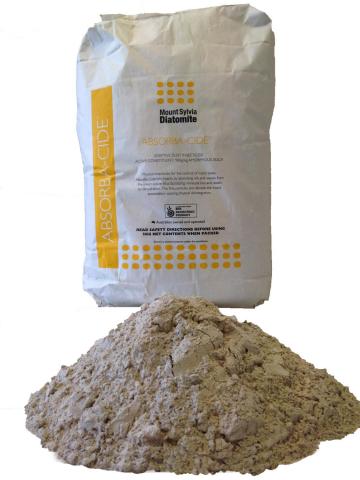Mount Sylvia Absorbacide Diatomite Super Fines (Diatomaceous Earth) 12.5kg
Mount Sylvia Absorbacide Diatomite Super Fines (Diatomaceous Earth) 12.5kg
While diatomite is non-toxic for humans as well as livestock and poultry, we do not endorse or recommend its use as a human food supplement. This is because it is not prepared under the sterile conditions approriate to this purpose.
WHAT DOES ABSORBACIDE DO? Absorbacide controls all economically important stored grain insect pests including weevils, beetles, borers, and moths. A single application provides 12 month protection against insect pests in: • Stored products such as wheat, barley, rice, corn, sorghum, lentils, peas and other stored commodities. • Warehouses and storage areas holding food products. • Empty silos and grain handling machinery such as combine harvesters, belt conveyors and bucket elevators
HOW DOES ABSORBACIDE WORK? The skeletons of diatoms are made up of silica. The processed diatomite desiccates the insect and the waxes and oils of the exoskeleton are then absorbed. The sharp silica shards are like razor blades to insects. Without their wax coating the insects quickly dry out and die. The non-chemical approach to insect control offers major benefits:.
ADVANTAGES OF ABSORBACIDE • Treated commodities remain chemical and residue free and there is no withholding period. This is an important issue for organic growers, exporters, and other produces of residue free food products. • Absorbacide is approved for use by one of the largest organic growers associations, the Biological Farmers of Australia (BFA). • It is unaffected by major changes in temperature. • It provides complete protection in normal nonventilated storage facilities. Sealed storage facilities are not required. • Because diatomite acts by physical means, insecticide resistance will not occur making it ideal for integrated pest management regimes.
CONFIRMATION OF EFFECTIVENESS Both the CSIRO and the Queensland DPI have confirmed the effectiveness of Absorbacide as a physical insecticide (Copies of reports from these agencies are to be found at www.mtsylviadiatomite. com.au). Many grain growers have adopted absorbacide for structural treatment of their handling, transport and storage facilities and/or grain protection. The AVPMA has approved Absorbacide as a dust insecticide that controls insect pests in farm stored feed grain.
COST Absorbacide treatment at a rate of 1kg/tonne through the conveyor, costs no more than chemical insecticide treatments. As a structural treatment, considerable cost savings are achieved. With a dust application rate of 2g/m 2 the treatment cost is only about 8% of that of chemical sprays. When sprayed on as a water based slurry at 6g/m 2 (dry basis), the cost is still less than half the cost of chemicals.
TREATMENT APPLICATIONS
Conveyor Application: Long-term protection is achieved by treatment of grain at a rate of 1kg Absorbacide per tonne. Any powder-dosing appliance can be used. The dust is added into a moving stream of grain at a steady rate to ensure an even distribution. Typical dosing points are auger hoppers, belt conveyors and bucket elevators. Aeration of the treated grain should start immediately if the grain is still warm or has a moisture content too high for long term storage. Absorbacide requires an air stream to move it onto surfaces and into crevices.
Dusting: For economy and efficiency it is recommended that bellow type dusters are used, however any garden duster can be used. When applying to large open grain stores, food warehouses or grain handling machinery, venturi blowers, such as the Blovac BV22 unit provide the best solution. These compressed air powered units can also be used to blow, or vacuum away grain debris from equipment and grain stores prior to treatment. Two-stroke backpack dusters can also be employed. In order to achieve an even coating on vertical surfaces, dust should be blown through top hatches of vertical silos. If the silo is fitted with an aeration fan, pour pre-weighed quantity of dust into the fan suction. For horizontal storage areas and warehouses, apply from top to bottom, starting with roof structures. The operator should wear a disposable dust mask.
Water Slurry: This novel method of application has received a high level of acceptance in the grain industry due to its cleanliness, speed of treatment, and excellent control of application rates.
Snow C a p Treat m e n t : Absorbacide dust coatings of 100g/m2 on the surfaces of bulk-stored grain have proven to be an important factor in controlled fumigation systems. The dust coating not only provides a barrier to insect infestation; it also maintains higher fumigant concentrations in the critical surface layer of the grain. The small amount of Absorbacide required adds little to the cost of the fumigation.
CONSTRAINTS ON PRODUCT USE As the insecticidal activity of Absorbacide lies in its drying properties, very high humidities reduce its effectiveness. It is not significant when the periods of high humidities are seasonal, e.g. a wet winter season, however, if high ambient humidities (70% or more) prevail throughout the year Absorbacide should be tested in that situation prior to regular use. For the same reason, treatment of damp food commodities should be avoided. Recommended moisture contents for long-term storage protection are: Wheat, Barley and Oats 13% or below Sorghum, paddy rice and corn 14% or below These moisture levels would normally be attained after routine aeration drying after harvesting and storage. Treatment of grain using desiccant dust insecticides such as Absorbacide, affects the physical properties of the grain. Flow rates are reduced and the angle of repose is increased. For this reason Absorbacide use may not be appropriate where treated grain is delivered to bulk handling facilities which meter grain flow rate along a delivery chute. This does not apply where Absorbacide has been used as a snow cap


